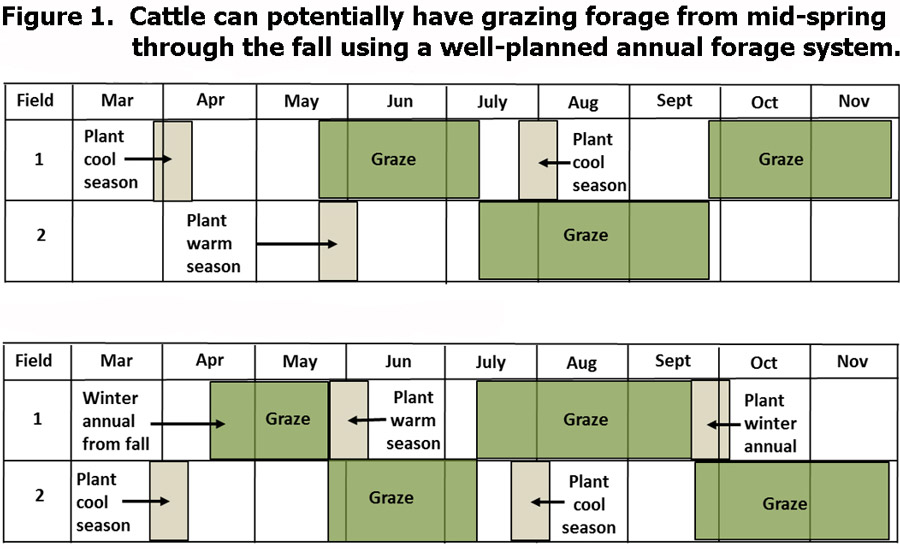Annual Forage Systems for Grazing
March 2016
With strong demand for summer pasture, producers are looking for alternatives to produce forage for grazing. Cattle can be grazed from mid-spring through the fall using an annual forage system. This involves timely planting of cool- and warm-season annual forages. These systems typically involve at least two fields and one or two plantings per field during the year (Figure 1 below).

Spring small grain cereal grasses such as oats and spring varieties of triticale, barley, and wheat can be planted in early spring to provide late-spring and early-summer grazing. They can also be planted in late summer to provide fall grazing. Brassicas such as turnips, rape, or kale can be mixed with these small grain cereal grasses. Most brassicas have high energy content even when mature and tend to maintain their quality later into the winter than the small grain cereal grasses.
Winter varieties of wheat, triticale, or cereal rye can be planted in the fall. These can provide earlier spring grazing than spring planting of spring varieties but will not produce as much fall growth as spring varieties planted in the late summer/fall.
Spring-planted small grain cereals or winter small grain cereals commonly yield about 2 to 3 tons per acre. Assuming rotational grazing is employed, a grazing efficiency (amount of forage produced that is consumed) of 50% is attainable, this would result in 2.5 to 4 AUM/ac of grazing. Forage production of small grains and mixtures of small grains and brassicas range from 1 to 3 tons per acre when planted from mid- to late-summer resulting in 1.3 to 4 AUM/ac of grazing. Higher yields are possible if planted earlier in mid-July to early August.
Warm-season annual grasses including sudangrass, sorghum-sudangrass or pearl millet can be planted from late spring through early summer to provide late summer grazing. Warm-season annuals would be expected to produce from 3 to 5 tons per acre. Using rotational grazing, a grazing efficiency of 40% for warm-season annual grasses is attainable; thus, 3 to 5 AUM/ac of grazing would be achievable.
Annual forages must be fertilized to reach their yield potential and fertilizer should be applied according to soil test recommendations. For warm-season annual grasses, nitrogen (N) is most often the limiting nutrient. Typically, 40 to 60 lbs of N per acre should be applied at establishment with an additional 50 to 60 lbs of N per acre applied after the first month of grazing, if needed. For cool-season annuals, 40 to 50 lbs of N per acre is typically needed.
Using the systems shown in Figure 1 (above) on irrigated cropland in Central Nebraska would likely require between 1.5 and 2.5 acres of land total per pair for 6 to 6.5 months of grazing. System A requires more acres per pair but has less input costs than System B. System B would result in a longer grazing period.
The costs associated with seed and seeding, nitrogen fertilization, and irrigation (16 to 19 inches per year) would be expected to range from $40 to $65 per pair per month in these systems. These estimates do not include property tax, fencing, or water.
Current pasture rental rates are at high enough levels to suggest there may be an opportunity to use annual forage systems economically. However, producers will need to take a serious look at their own situation to determine if an annual forage system will work on their operation.
For more detailed information, please see the Planning Annual Forage Systems guide.
Mary Drewnoski
Nebraska Extension Beef Systems Specialist
Jerry Volesky
Nebraska Extension Range and Forage Specialist